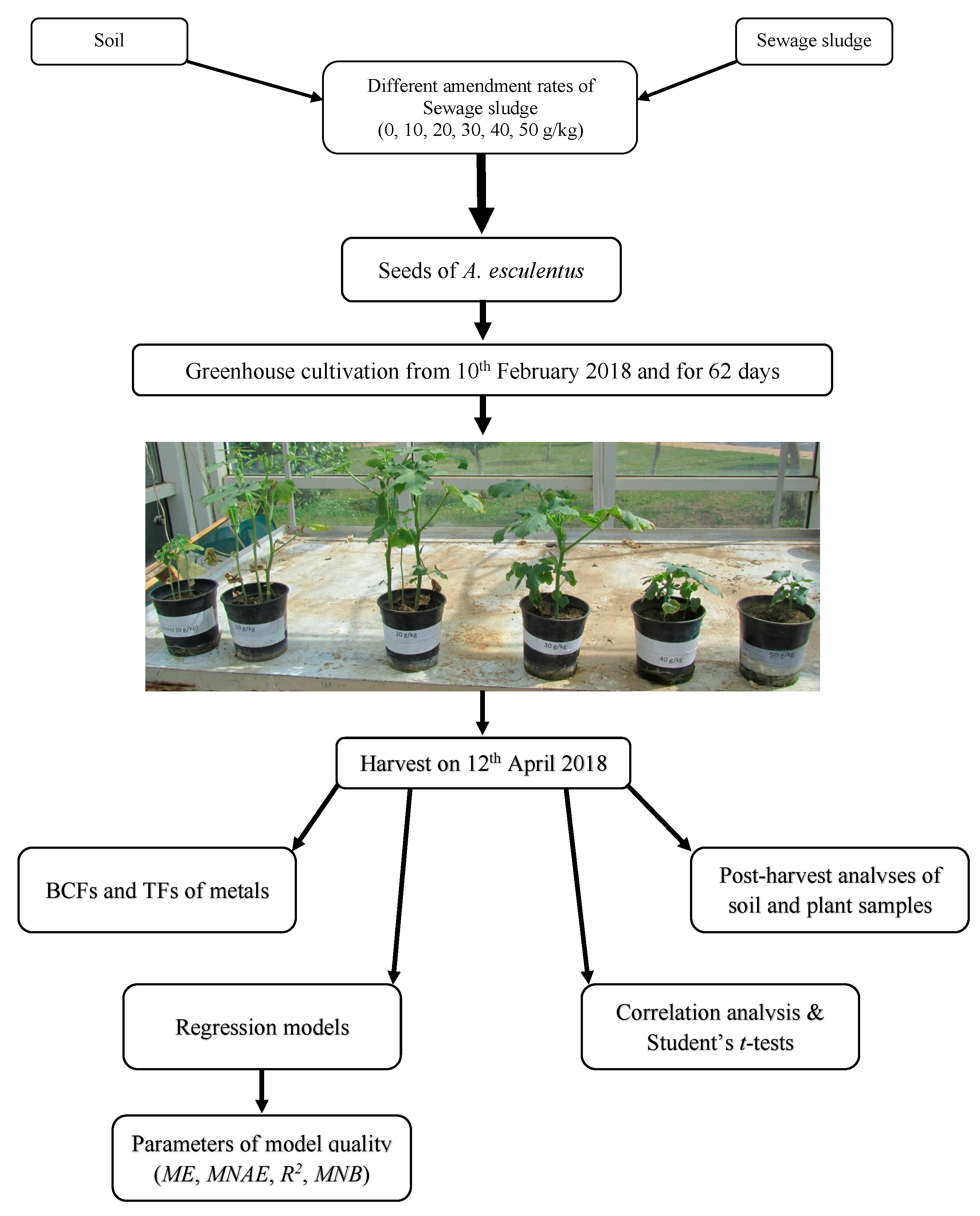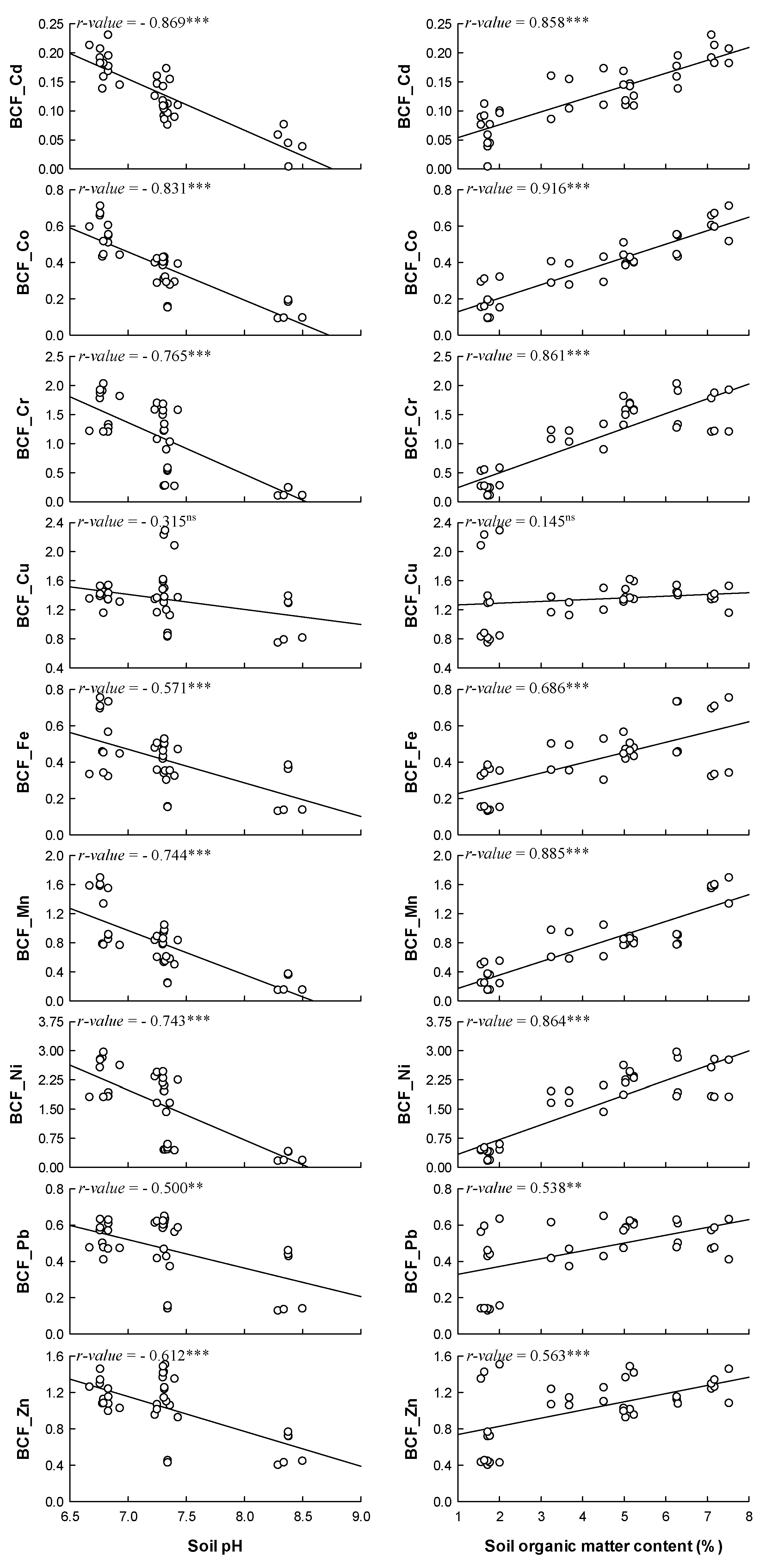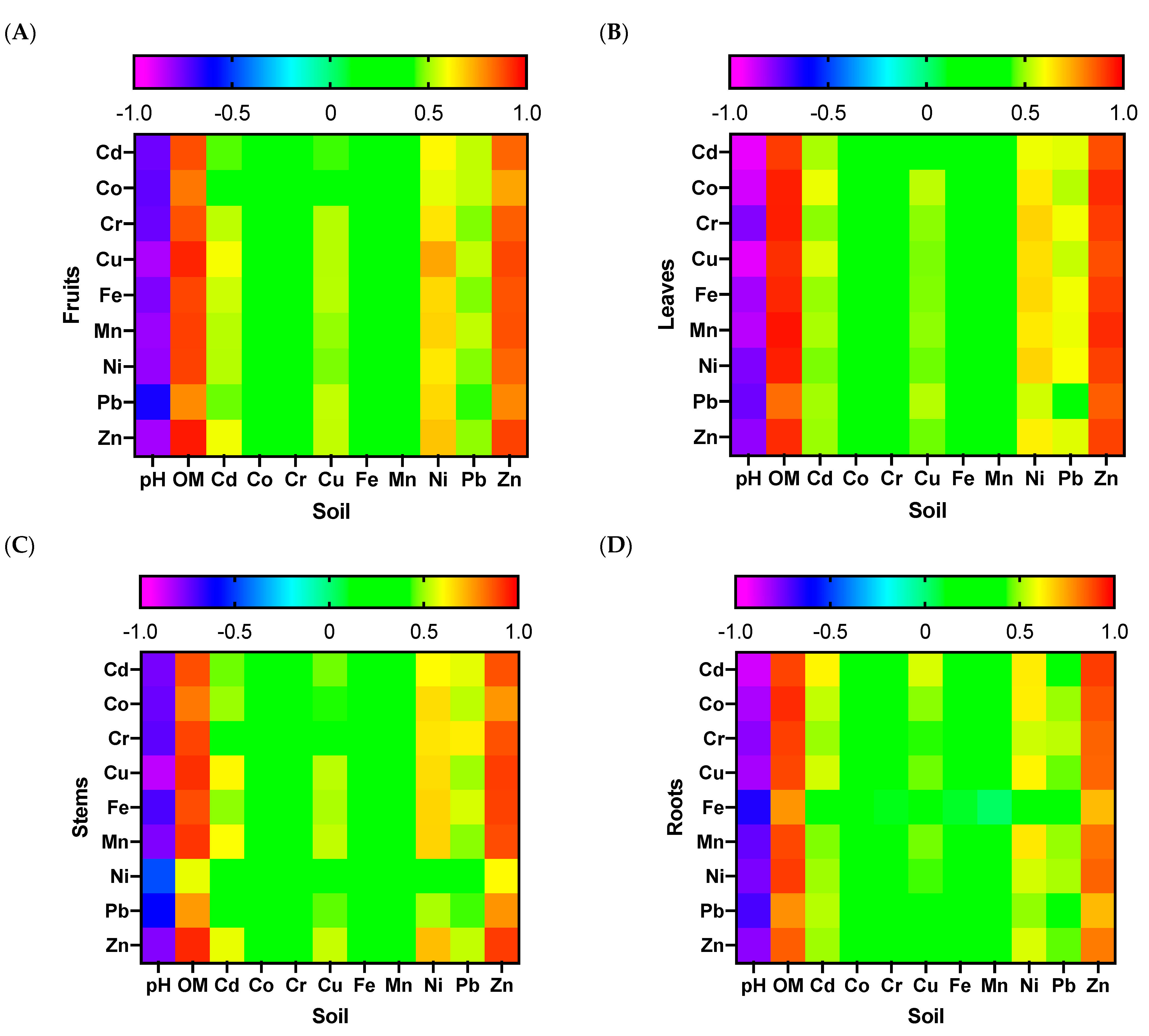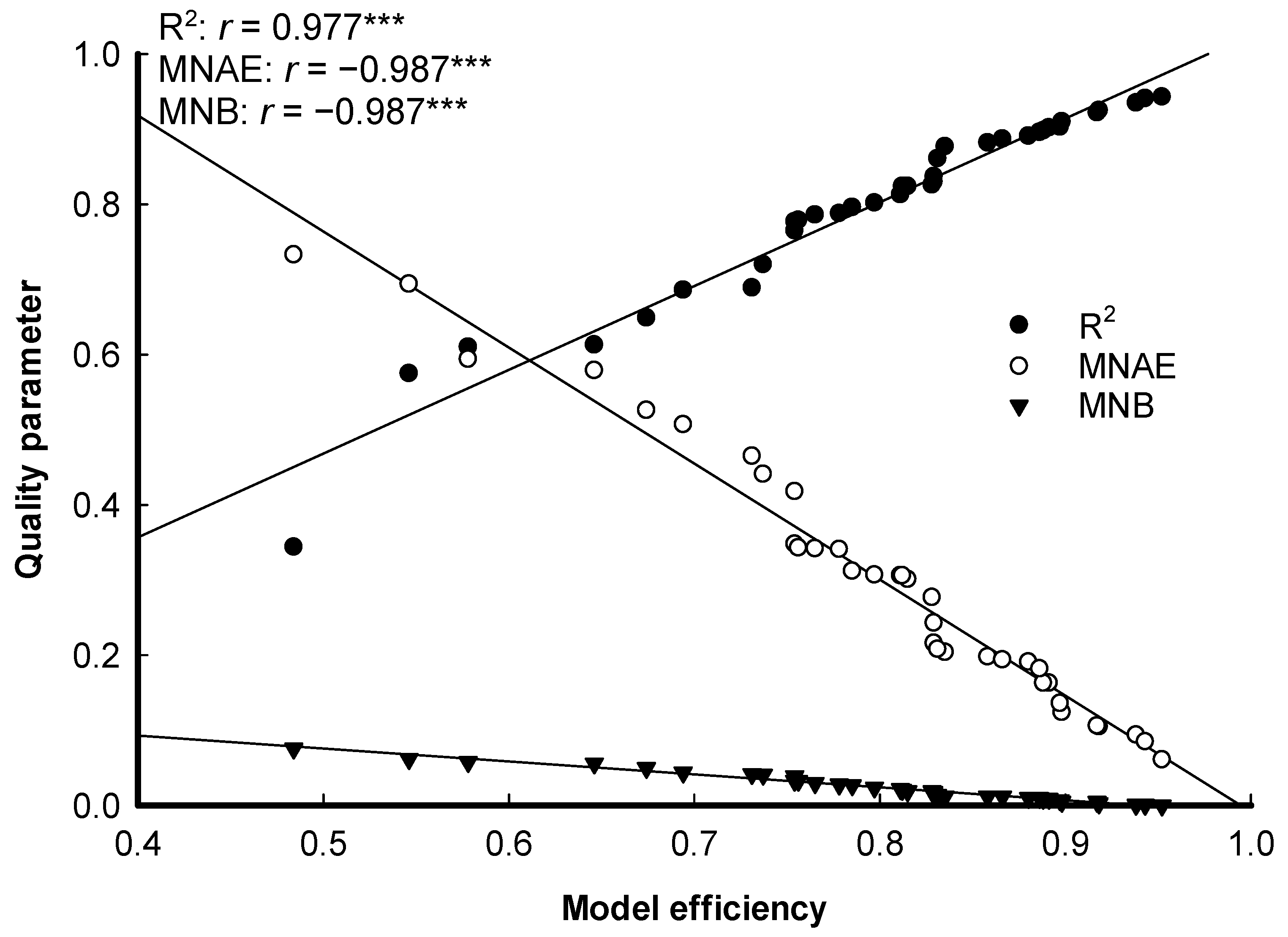1. Introduction
The technical implications involved in the proper disposal of modern municipal wastes have made it essential to develop alternative waste management approaches that reduce the environmental impacts resulting from improper disposal [
1]. Metropolitan waste materials such as bio-solids (e.g., sewage sludge) contain high concentrations of key nutrients for crops including trace elements as well as micro and macro-nutrients. These have the potential to enrich growing media and thus reduce the requirement for chemical fertilisation. Nevertheless, a notable disadvantage in the use of bio-solids is the risk that they may contain toxic metals, which restrict their agricultural applications [
1].
Metals are a particular group of elements that, unlike organic pollutants, cannot be degraded through biological processes [
2]. Increased attention has been focused on metals due to their harmful negative effects on the environment [
3]. Usually, the most important avenues of exposure are the consumption of contaminated foods, the inhalation of suspended air particles, the direct ingestion of soil, and the consumption of contaminated drinking water [
4,
5]. Metal contamination may originate from both natural geochemical processes (e.g., weathering of ultramafic rocks) and anthropogenic sources [
6]. Direct anthropogenic sources of metals affecting the environment are fertilizers, pesticides, mining, electroplating, industrial effluents, sewage sludge, and atmospheric deposition [
7].
In
Abelmoschus esculentus (L.) Moench. (i.e., the okra plant), the accumulation of Cd has had an adverse impact on its biological and biochemical properties, cultivation, and harvest [
8], thus implying that
A. esculentus is not an appropriate species to be grown in soil containing significant Cd levels. It was subsequently demonstrated that a combination of Cd and Zn enhanced Zn accretion but diminished Cd uptake in the plant’s roots, stems, and leaves. It was concluded that the two metals demonstrated antagonistic actions when utilised together, leading to a lower absorption of Cd. Srivastava et al. [
9] proposed that MSWVC has potential as an organic additive to soil, as evidenced by a high harvest rate and the antioxidative reaction of
A. esculentus at varying MSWVC proportions of up to 60% concentration. If MSWVC were employed in the agricultural sector, it could mediate the negative impact of the increase in organic solid waste. One study reported that
A. esculentus plants were found to have the following metal concentrations (mg/kg): Mo, 7.0–9.3; Fe, 39.7–44.1; Cu, 11.8–19.8; Zn, 28.2–37.1; Ni, 6.1–9.3; Pb, 4.9–7.1; Cd, 3.4–4.2; and Co, 0.1–0.3 [
10]. These concentrations were under the maximum of permitted metal levels in plant specimens, with the exceptions of Mo and Cd. Using wastewater for irrigation heightened the fertile properties of the soil, and only a fraction of the metals contained in the wastewater accumulated in the plants’ tissues [
11]. A further study noted that the deployment of 100% distillery effluent for irrigation elevated Zn, Cu, Cd, Ni, and Cr levels, but diminished the number of soil microorganisms, i.e., bacteria, fungi, and actinomycetes [
12]. In the soil and in
A. esculentus, the metal concentrations were ranked Ni > Cr > Cd > Zn > Cu and Ni > Cr > Cu > Cd > Zn, respectively. The metal concentrations (in mg/kg) were all under the recommended permissible limit (for plants, Cd: 0.2–1.5, Ni: 1.5–10, Cu: 40, and Zn: 50–100; for soil: Cd: 0.06–6, Ni: 30–150, Cr: 100, and Zn: 50–600) [
12].
To reduce the toxic effects of metal and their translocation to food chains, it is important to estimate the impact of soil variables on the bioavailability and uptake of metals by plants [
13]. The simple estimation of the BCF can serve as a rough insight into the range of metal uptake, but it does not reflect more detailed site-specific conditions of the soil [
14]. Valuable mathematical approaches and regression models can be applied to forecast specific dependent variables (e.g., metal concentrations within plant tissues) using variables independent of the soil (e.g., metal concentration, pH, and OM content) [
13,
15,
16,
17]. Once generated, such models can be employed to determine the impact of sewage sludge use with respect to crops such as
A. esculentus. To date, no regression models for the absorption of metals by
A. esculentus grown in soil modified with sewage sludge have been established. Thus, the present study aims to establish mathematical regression models that include specific soil parameters as explanatory independent variables (i.e., metals, pH, and OM content) to predict the concentration of the most common metals (Cd, Co, Cr, Cu, Fe, Mn, Ni, Pb, and Zn [
18]) in the four tissues of
A. esculentus (i.e., fruit, leaf, stem, and root) cultivated in soils amended with different proportions of sewage sludge. It is predicted that these models may improve the assessment of the hazards associated with the use of sewage sludge for crops and assist investigations into the safety of growing
A. esculentus in soil fortified with this waste product.
3. Results
The highest pH noted in the field soil was 8.7. This soil also contained the greatest concentrations (mg/kg) of Cd, 2.9; Co, 35.5; Fe, 42.4 × 10
3; and Mn, 677.3. The EC and the OM content were higher in the sewage sludge, 14 mS/cm and 65.0%, respectively. The sewage sludge also demonstrated elevated concentrations (mg/kg) of Cr, 176.2; Cu, 162.6; Ni, 138.7; Pb, 671.1; and Zn, 667.6 (
Table A1). Following the
A. esculentus harvest, an alkaline pH of between 6.7 and 8.5 was measured in the soil–sludge admixture; the mean pH was 7.3, and the CV was 7.3%. The pH spectrum of the OM content was 1.6–7.5%; the mean was 4.3% and the CV, 49.6% (
Table 1). In the soil modified with sewage sludge, the highest and lowest mean metal values (mg/kg) identified were for Fe, 30.9 × 10
3, and Cd, 2.8 (
Table 1). The soil metal concentrations ranked in order of concentration were Fe > Mn > Cr > Zn > Ni > Co > Cu > Pb > Cd.
When
A. esculentus tissues were examined, the fruits contained the least quantity of metals, apart from Cd (
Table 2). With the exception of Cd, the roots were found to have accumulated the greatest concentration of metals, as compared to the above-ground plant components. The results of the metal assays from the plant parts, ranked in descending order, were the fruits, Fe > Mn > Zn > Cu > Ni > Co > Cd > Cr > Pb; the leaves, Fe > Mn > Zn > Cu > Cr > Ni > Co > Cd > Pb; the stems, Fe > Mn > Zn > Cu > Cr > Co > Pb > Ni > Cd; and the roots, Fe > Mn > Zn > Cr > Ni > Cu > Co > Pb > Cd. Overall, the sum of the metal concentration (mg/kg) within the varying plant tissues can be ranked in the order: the roots (13,795.5) > the leaves (1252.7) > the fruits (489.3) > the stems (469.6).
For five of the metals (i.e., Cd, Co, Fe, Mn, and Pb), the BCF was <1; for the remaining four metals, the BCF was >1 (i.e., Cr, 1.074; Cu, 1.347; Ni, 1.576; and Zn, 1.031). The above-ground tissues exhibited a TF < 1 for all the metals, apart from Cd, with respect to the leaves (2.003) and the fruits (2.489) and with the exception of Mn (1.149) in relation to the leaves (
Table 3). The soil pH and the BCF for all the metals were negatively associated; the highest and lowest correlations were demonstrated by Cd (
r = −0.869) and Cu (
r = −0.315), respectively. The soil OM content had a positive relationship with the metal BCFs, with the highest and lowest correlations exhibited by Co (
r = 0.916) and Cu (
r = 0.145), respectively (
Figure 2). Mostly, the metal concentrations in all four
A. esculentus tissues were positively associated with the corresponding metal concentrations in the soil (
Figure 3). Several negative relationships were identified between the soil pH and the tissue metal concentrations, whereas an opposite pattern was seen in relation to the tissue metal concentrations and the soil OM content.
With respect to the fruits, the regression equation for Zn displayed the largest variation coefficient (
R2 = 0.922) and was linked with the most sizeable
ME (0.915) and smallest
MNAE (0.106) and
MNB (0.005). Co demonstrated the equivalent parameters for the leaves (
R2 = 0.943;
ME, 0.952;
MNAE, 0.052;
MNB, 0.000) (
Table 4). Cu displayed these features for the stems (
R2 = 0.903;
ME, 0.897;
MNAE, 0.136;
MNB, 0.007) and Cd, for the roots (
R2 = 0.896;
ME, 0.886;
MNAE, 0.182;
MNB, 0.010). Students’
t-tests indicated that any differences between the measured and forecasted concentrations of the nine metals within the four tissue types of
A. esculentus failed to reach significance. For all the metals in the four plant components,
MNAE < 0.50, apart from Pb in the fruits (0.579); Ni (0.733), Pb (0.694) and Co (0.507) in the stems; and Fe (0.594) and Pb (0.528) in the roots. When
ME was plotted along the X-axis against
R2,
MNAE, and
MNB, respectively, on the Y-axis, a positive simple linear correlation was noted for
R2 (0.977), and negative associations were observed for
MNAE (−0.987) and
MNB (−0.987) (
Figure 4).
4. Discussion
The pH of the soil sludge-growing medium for
A. esculentus was slightly alkaline at 7.3. Alkalinity is well-established as promoting the adsorption of numerous metal elements and thus diminishing their solubility in soil solutions [
13,
15]. The governing factors for the movement and the bioavailability of metals in soil include the adsorption and desorption characteristics of the soil [
29], which are linked with the soil’s OM content, pH and clay mineral content, and oxidation-reduction state [
30,
31]. Soil pH and the majority of the assayed metals in the component tissues of
A. esculentus demonstrated a negative relationship. The pH of soil has been noted to play a key part in defining soil metal solubility and availability [
32]. Conversely, positive associations were identified between the soil OM content and the metal concentration in the various
A. esculentus tissues. The OM content participates in the governance of availability and movement of the metals in soils; it is a source of organic chemicals that behave as chelating agents and promote the bioavailability of metals to plants [
13]. Following the degradation of the OM content, soluble organic metal complexes are generated that enhance metal bioavailability [
33]. Although, Eid et al. [
1,
17] suggested that sewage sludge could be a valuable fertilizer to improve growth, yield, and plant constituents of crops, sewage sludge should be utilised with caution and in controlled circumstances in order to diminish the metal accretion in soil and the subsequent metal uptake by plants.
The cumulative uptake of metallic elements by plants involves and relies on a number of soil characteristics, the components of the sewage sludge and the concentration used, the species phenology and physiology, the biochemistry related to the rhizosphere, climate characteristics, the influence of chelation, and chemical metal speciation [
17,
34,
35]. The principal source of metal accretion and filtering in plants is thought to be the root system, which takes up metals at a slow rate, especially if they are available in significant quantity, and thus inhibits or reduces their mobility to the areal plant components [
24,
36]. The current research reinforced this perspective; practically all the metals were present in a higher quantity in the root systems of
A. esculentus as opposed to in the stems, the leaves, or the fruits. If there were a root system hyper-accretion of metals, this could arise from the formation of metal complexes with sulphydryl moieties, which leads to a lower rate of metal transfer to the above-ground plant parts. A further reason why roots may demonstrate a higher metal concentration is that they are the initial plant components to be exposed to these elements within the soil [
37]. In a species, such as
A. esculentus, this is a favoured mechanism, as it suppresses the accumulation of toxic metal concentrations in the edible above-ground plant tissues, especially in the fruits that are used as foods in their young and desiccated forms. The three metals with the highest concentrations in the
A. esculentus tissues and the soil-sludge admixture in descending ranking were Fe > Mn > Zn, implying that these were more straightforward to accumulate within the plant owing to their raised concentrations in the medium and their vital nutrient value for plant growth [
34,
38]. Pb and Cd demonstrated poor uptake within the plant tissues; when it occurred, these metals were identified in the plant roots [
39].
When sewage sludge is added to cultivated soil, it frequently causes soil contamination as well as the accumulation and toxic impact of metals within the food chain. The concentrations of the tested metals in the sewage sludge in the present experiment, with the exception of Cd and Fe, were within proposed normal limits [
7]. Furthermore, all nine metals, apart from Fe, were under the maximum safe limit in the tissues of
A. esculentus [
7]. The combination of cultivated growing media with sewage sludge may be admissible for some food crops but not all [
35]. Frequent assays to confirm the metal concentrations present in such an admixture is advised to avoid the addition of toxic metals to foodstuffs.
The negative correlations identified between the soil pH and the plant metal concentration could be explained by the diminished soil availability of the metals in a basic soil solution; in contrast, a more acidic environment would enhance metal availability [
13,
16,
40]. Conversely, the positive associations between the OM content in the soil and the concentrations of the metals in
A. esculentus tissues could be due to the heightened mobility of metals in the soil induced by the OM content, together with their absorption by the plant [
41], a result that confirms previous research [
13,
15,
42].
Although BCF is an approximate gauge for metal uptake, it offers little information about the location properties [
13]. In the present study, the BCFs were negatively and positively influenced by the soil pH and the OM content, respectively. For the five metals (i.e., Cd, Co, Fe, Mn, and Pb) for which the BCF was <1, this could reflect that the root system’s ability to uptake these metals is poor, or that they are absorbed in small quantities [
16]. Where the BCF was >1 (i.e., for Cr, Cu, Ni, and Zn), this implies that
A. esculentus roots work as hyper-accumulators and could be employed as phytoremediators with respect to these elements. Apart from Cd and Mn in the leaves and Cd in the fruits, the TF was <1, indicating that the roots behave as an efficacious biological filtration system for the majority of the metals investigated, except for Cd and Mn.
Investigating the effect of soil variables on the bioavailability and the uptake of metals by plants is important for reducing the toxic impacts of these metals in agricultural ecosystems [
43]. Regression models identify statistically significant soil properties that affect the uptake of metals by plants, and this process can enable a significant reduction in the transfer of these metals to the food chain and, thereby, reduce the risk to living organisms [
44]. Regression models form a useful if involved strategy and enable the forecast of the metal concentrations in plant components based on soil variables (e.g., metal concentrations, pH, and OM content) [
35]. Data from the current experiment indicate that the designed mathematical models relating to
A. esculentus uptake exhibited high accuracy for the majority of the tested metals when viewed in relation to measures of model quality, i.e.,
R2,
ME,
MNAE and
MNB. Furthermore, it was noted that all the estimated soil variables (i.e., metal, pH, and OM content) impacted the plant uptake of the metals, which was in agreement with previous studies [
42,
44,
45,
46].
Since there is not much literature available relating to the establishment of regression models specifically for the absorption of metals by
A. esculentus grown in media combined with varying sewage sludge concentrations, the obtained data were compared with studies that evaluated similar concepts using regression models pertaining to alternative crops. When judged against the tissues of
A. esculentus in which Cd variability was 77.7–92.5%, Cd variabilities within the plant components for cucumber [
1], barley [
43], kidney bean [
47], garden pea [
48],
Corchorus olitorius [
49],
Eruca sativa [
50], and spinach [
51] were 49–76%, 45–88%, 44–61%, 25–67%, 69–75%, 49–81%, and 83–88%, respectively. Bešter et al. [
44] used models to measure the impact of Cd in tomato and endive, which exhibited
R2 values of 41% and 90%, respectively.
R2 parameters in relation to Cd for
Urtica dioica as well as
Agrostis and
Poa species were documented as 10–47% and 31–38%, respectively [
42], whereas
R2 values of 45% and 47% were obtained for lettuce and carrot, respectively [
45]. Some earlier publications may have demonstrated lower parameters of
R2 for several of the models (
Table A2), owing to the increased replicate frequency utilised to develop the model, which also creates significant data noise that, in turn, impacts the predictive accuracy of the affected models [
52]. The degree of contaminants, the physicochemical properties of the soil at the sampling locations, the soil grade, the degree of microbial activity, the various soil derivations and mineral contents, the differing land management strategies, and the techniques utilised for sample digestion [
7,
53,
54] may also produce the variations in
R2 seen amongst the models.
In this work,
ME correlated positively with
R2, but negatively with
MNAE and
MNB, respectively. Within the plant tissues of
A. esculentus—with certain exceptions, namely, Pb in the fruits; Ni, Pb and Co in the stems; and Fe and Pb in the roots—
MNAE parameters were calculated to be <0.50 for all the investigated metals. If
MNAE ≤ 0.50, this has been proposed to represent consistency between the model and measured metal concentrations, implying that the model is a good fit [
16]. Shaltout et al. [
35] reported equivalent findings in relation to
Sorghum bicolor cultivated in field soil that was mixed with sewage sludge.
5. Conclusions
In order to gauge the ways in which the nine investigated metals (i.e., Cd, Co, Cr, Cu, Fe, Mn, Ni, Pb, and Zn) would be absorbed by A. esculentus, regression models were designed using selected soil properties as input variables. The concentrations of the nine metals in the plant tissues of A. esculentus demonstrated negative and positive correlations with the soil pH and OM content, respectively. The models, with the exception of those with MNAE parameters ≥ 0.50, exhibited high performance, efficacy, and only a modest level of inaccuracy. These data reinforce the models’ feasibility for the examination of A. esculentus grown in sewage sludge-modified growing media. The models also provided apposite data for the majority of the tested metals in relation to the tissues of A. esculentus. The utilised model variables are pertinent to a spectrum of biological utilities since they can be assayed at frequent intervals. The most notable advantage of the constructed models was that they were efficient with respect to time and expense, since they reduced the dataset size necessary to establish significant soil properties. On the other hand, the reduction in the necessary dataset size may be misleading, as only statistically significant explanatory variables are included in the regression model. Another important downside of regression models is that their predictions are valid only within the sampled interval of the explanatory variables (e.g., concentrations of metals in soil) and that the results of regression models are only reliable when the soils and plant samples present a representative statistical sample. In general, the very careful use of models within a range of site-specific parameters is necessary. The quality of models also depends on the degree of variability explained. Therefore, the authors advise that these models should be utilised with an explained variability of R2 > 50%. We encourage other researchers to use our models according to their own specific conditions. Moreover, there are also interactions between soils and other environmental properties. Thus, the model results must be interpreted while accounting for unknown variables. Additionally, more studies should investigate the uptake and associated health risks of other toxic elements (e.g., As, Hg, etc.) that may be present in the applied sewage sludge.













